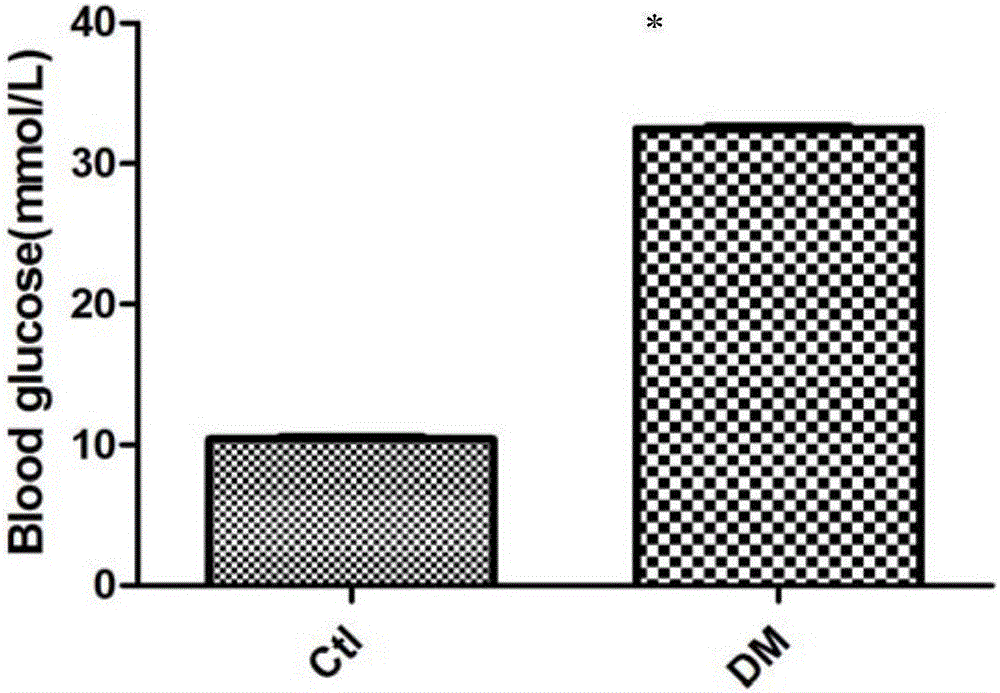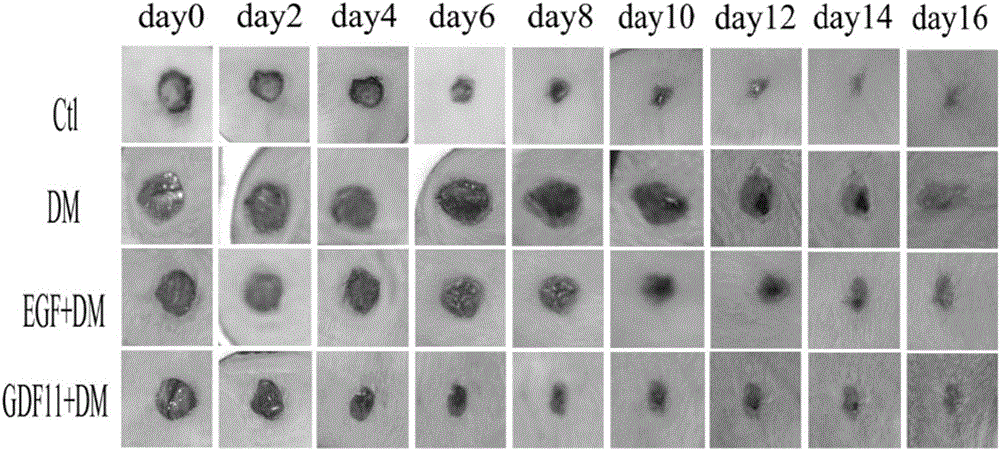Use of growth differentiation factor 11 in promoting healing diabetic wound
A growth differentiation factor, wound healing technology, applied in the field of medicine, can solve the problems of difficult healing of diabetic wounds, infection gangrene, vascular granulation, epithelial formation and remodeling and other problems that the healing process cannot be completed.
- Summary
- Abstract
- Description
- Claims
- Application Information
AI Technical Summary
Problems solved by technology
Method used
Image
Examples
Embodiment 1
[0030] The establishment of embodiment 1 mouse diabetes model
[0031] Get 60 mice, fast without water for 12h, inject STZ solution (10mg / ml) intraperitoneally by 1.8mg (STZ) / 10g mouse body weight, then give 5% glucose water for 12h, and resume normal eating the next day. water. After 7 days, the postprandial blood glucose value was measured, and the mice with blood glucose concentration higher than 16.7mmol / L were regarded as diabetic mice (DM), that is, the modeling was successful. figure 1 shown.
Embodiment 2
[0032] Example 2 Establishment of Mouse Diabetic Wound Model
[0033] Take 30 diabetic model mice and 10 normal mice, inject Avertin solution (0.02g / ml) intraperitoneally according to the standard of 0.10ml / 10g mouse body weight, carry out anesthesia, remove the hair on the back to expose the skin, and use a skin puncher , A circular full-thickness skin wound with a diameter of 5 mm was made on the lower 1 / 3 of the back of the mouse (including the subcutaneous tissue of the epidermis and dermis. It is better to see the subcutaneous muscles and bones after punching and cutting off the skin). Each mouse was housed in a single cage.
Embodiment 3
[0034] Example 3 Grouping and Administration of Diabetic Wound Model Mice
[0035]Thirty diabetic wound model mice were randomly divided into 4 groups: (1) blank control group (DM): 0.1% BSA buffer was added to the wound; (2) positive control group (EGF+DM): the wound was dripped with 50ng / ml epidermal growth factor (EGF) solution; (3) Experimental group (GDF-11+DM): 50ng / ml GDF-11 solution was added to the wound; in addition, non-diabetic normal wound model mice (10) were used as negative controls Group (ctl), wherein the amino acid sequence of GDF-11 (purchased from Peprotech company) is as Figure 5 shown.
[0036] Dosing method: The administration frequency of the positive control group, the experimental group, the blank control group and the negative control group is to administer twice a day for each wound, and the administration time point is fixed, and the total volume of each administration is 10ul. The way of medicine is smearing, and the formulations of the medici...
PUM
 Login to View More
Login to View More Abstract
Description
Claims
Application Information
 Login to View More
Login to View More - R&D
- Intellectual Property
- Life Sciences
- Materials
- Tech Scout
- Unparalleled Data Quality
- Higher Quality Content
- 60% Fewer Hallucinations
Browse by: Latest US Patents, China's latest patents, Technical Efficacy Thesaurus, Application Domain, Technology Topic, Popular Technical Reports.
© 2025 PatSnap. All rights reserved.Legal|Privacy policy|Modern Slavery Act Transparency Statement|Sitemap|About US| Contact US: help@patsnap.com



